

Medical Madness: Practices of the Victorian Era. Medical Madness: Practices of the Victorian Era Desiree Krauss Although many of us fantasize about the Victorian era, there were many unsafe and scary practices that make us very grateful for modern education and technology.
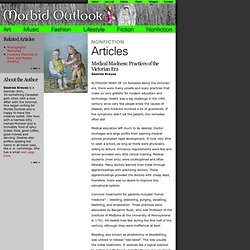
Health was a big challenge in the 19th century since very few people knew the causes of disease, and medicine involved a lot of guesswork. If the symptoms didn’t kill the patient, the remedies often did! Medical education left much to be desired. Common treatments for patients included “heroic medicine” – bleeding, plastering, purging, sweating, blistering, and amputation. Bleeding, also known as phlebotomy or bloodletting, was utilized to release “bad blood”.
Plastering referred to a paste-like substance made from a variety of ingredients and then applied to the skin of the patient, such as on the back or chest to relieve colds or internal pain. Purging involved giving a patient heavy doses of laxatives or emetics to expel “poisons” from the body. History - British History in depth: Victorian Medicine - F. Medicine in the Victorian Age. Public Health in Jane Eyre and the Victorian Era. Mrs.
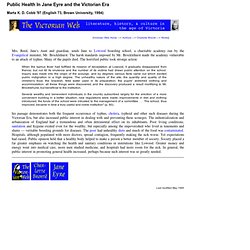
Reed, Jane's Aunt and guardian, sends Jane to Lowood boarding school, a charitable academy run by the Evangelical minister, Mr. Brocklehurst. The harsh standards imposed by Mr. Brocklehurst made the academy vulnerable to an attack of typhus. Many of the pupils died. When the typhus fever had fulfilled its mission of devastation at Lowood, it gradually disappeared from thence; but not till its virulence and the number of its victims had drawn public attention on the school. Several wealthy and benevolent individuals in the country subscribed largely for the erection of a more convenient building in a better situation; new regulations were made; improvements in diet and clothing introduced; the funds of the school were intrusted to the management of a committee . . . His passage demonstrates both the frequent occurrence of typhus, cholera, typhoid and other such diseases during the Victorian Era, but also increased public interest in dealing with and preventing these scourges.
Emergence of occupational medicine in Victorian times. Medical doctors in the Victorian Era... After much tasking and trouble, I have finally formalized my medical certifications.
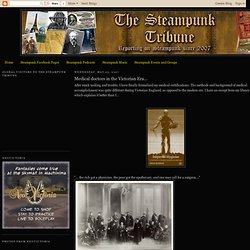
The methods and background of medical accomplishment was quite different during Victorian England, as opposed to the modern era. I have an except from my library which explains it better than I... "... the rich got a physician, the poor got the apothecary, and one may call for a surgeon... " Physicans had the most prestige in the 1800s.
They were called physicians because they only administered drugs, or "physic". "Professional practice" as George Eliot dryly observes in Middlemarch, "chiefly consisted in giving a great many drugs. There was no systemof medical school training and only a handful of hospitals (in 1851 there were only some 7,500 hospitals in the United Kingdom, out of a population of 18 million). Next below the physicians in the medical hierarchy were the Surgeons. If you really wanted to find out what was going on in the surgical world, you went to Edinbrugh and Paris. . - Pool, D. (1993). Victorian Medicine–painkillers « Slip Into Something Victorian. So I “borrowed” (re: stole) this book from my stepfather years ago.
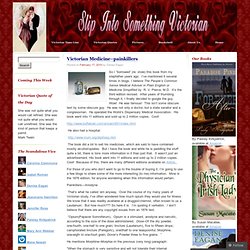
I’ve mentioned it several times in blogs, I believe The People’s Common Sense Medical Adviser in Plain English or Medicine Simplified by R. V. Pierce, M.D. It’s the third edition revised. After years of thumbing through it, I finally decided to google the guy. He also had a hospital: For those of you who don’t want to go to the trouble of buying it, I’m going to use a few blogs to share some of the more interesting (to me) information. Painkillers—Anodyne That’s what he called ‘em anyway. “Opium(Papaver Somniferum). He mentions Morphine–Morphia–in the previous (very long) paragraph: “When the stomach is very sensitive and will not tolerate their internal adminstration, one-sixth of a grain of Morphia can be inserted beneath the skin by means of a hypodermic syringe.
Painkillers for children: “Children can safely take only minute doses. Like this: Like Loading... Filed under: Uncategorized Tagged: | Laudanum, Morphine, R.V. An Analysis of Nursing Observation in the Late Victorian Era. World History Blog: Victorian Medicine. Victorian Medicine - A comprehensive study by Henry Hattemer of professional and traditional medicinal practices, practitioners, scientific theory, and health trends in England between the years 1830 and 1910.
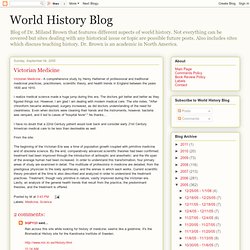
I realize medical science made a huge jump during this era. The doctors got better and better as they figured things out. However, I am glad I am dealing with modern medical care. The site notes, "After chloroform became widespread, surgery increased, as did doctors understanding of the need for cleanliness. Even when doctors were cleaning their hands and the instruments, however, bacteria was rampant, and it led to cases of 'hospital fever'. " I have no doubt that a 22nd Century patient would look back and consider early 21st Century American medical care to be less than desireable as well.